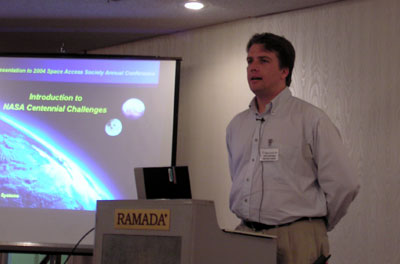Beware prize fatigueby Tom Hill
|
| Prizes fall into two categories: bold and huge versus mundane. |
The other type of prize, the type mostly discussed at the workshop, is more mundane. An example of one such prize, the subject of a rules-definition meeting, was the micro-return capsule. The idea is to allow easy return of small (on the order of one to ten kilograms, about the size of a coffee can) samples and products from a space station. I agree that this is something worth doing. Currently, the opportunities to return material from the station are more limited than the opportunities to deliver things to the station (Soyuz and Progress vehicles deliver crew and supplies, while only Soyuz capsules can return material and crew to Earth) and an additional capability to send things to Earth would be useful. This type of prize raises some questions, however, that reach into the heart of a prize approach. What kind of press interest will it inspire? What kind of stand-alone business opportunities exist for sample delivery from orbit?
This discussion is where the old-guard aerospace engineering mindset came out to put a damper on the proceedings, with varying correctness and applicability. Questions and statements such as “Who will pay for the launch?” “If you’re going anywhere near the ISS, Johnson Space Center will kill your project with safety reviews!” “How many times does someone have to demonstrate this before it’s considered successful?” “Will NASA award a contract to the winner?” and “What happens to the IP?” (When I first heard this acronym, I was stuck on Internet protocol, but found out that in this context the IP stood for intellectual property).
It’s possible that those types of questions are some last vestiges of the old-guard aerospace industry trying to hold on to their oft-described monopoly, but I don’t think so. Another way to look at it is that the people asking the questions been through projects similar to some of these proposed prizes and been burned, and they’re trying to set the rules so that some can succeed where they failed in the past. One common thread in most of these concerns is how to get to orbit.
No matter what the project, one fact that remains is that a ride into orbit is the biggest hurdle for the sample-return mission and others like it, with the cheapest launch opportunities lying outside The United States, off-limits for the prize competition. NASA’s stated that they’re trying to get prize rules written to allow launches on foreign vehicles, which opens the prospect of relatively cheap flights to LEO but also raises the specter of export control regulations on a prize-competing spacecraft. Is this starting to sound like an old-fashioned NASA project yet?
Perhaps the criteria for the differences between a “spectacular” and a “mundane” prize are the promises of a free-standing business venture after said prize is won. For example, Burt Rutan and Paul Allen have already created a company to take SpaceShipOne’s technology forward in the case they like the answers they get about operations and maintenance costs for their experimental project. Assuming that the technical and regulatory hurdles remaining for the venture are cleared, an optimistic viewpoint is that they could be flying paying customers by the end of this year. In the case of a sample return capsule from low Earth orbit, the only viable source of income right now is a government-run, partially-completed, undermanned international project known as the ISS. It’s possible that another station will fly in the coming years, but can a sample-return capsule production business survive the intervening years between winning a prize and selling their services to a possible commercial station without continuing business from the existing station?
| Perhaps the criteria for the differences between a “spectacular” and a “mundane” prize are the promises of a free-standing business venture after said prize is won. |
Another factor that NASA must contend with is something I call prize fatigue. This will come into play when there are dozens of small prizes available for competition, diluting the number of inventors/entrepreneurs and news agencies interested in each particular prize. It’s true that more than 20 teams showed varying progress vying for the X Prize, but how many are going to turn out for an astronaut glove improvement prize? How will the numbers change when there are simultaneous prizes for aerocapture demonstrations and sample return missions from the Earth going on? We’ll have to see.
Of course, one of the advantages of prizes is that no money is paid unless the prize is won. That sounds great in theory, but how many managers want to run a program where the stated goal is to give out prizes, and only 10% of the prizes are being won or competed for? This is another area where the old-school aerospace/government mindset may detract from the lofty goals of Centennial Challenges.
Let me reiterate that I’m very much in favor of the Centennial Challenge program. If allowed to by contest rules, I’d like to compete. I will watch with interest, though, to see if NASA and Congress are maverick enough to give the Centennial Challenges their due, and whether there are enough maverick inventors in our nation to answer a large number of challenges.
